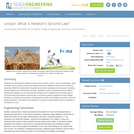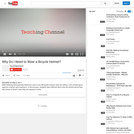
Students are introduced to Newton's second law of motion: force = mass x acceleration. After a review of force, types of forces and Newton's first law, Newton's second law of motion is presented. Both the mathematical equation and physical examples are discussed, including Atwood's Machine to illustrate the principle. Students come to understand that an object's acceleration depends on its mass and the strength of the unbalanced force acting upon it. They also learn that Newton's second law is commonly used by engineers as they design machines, structures and products, everything from towers and bridges to bicycles, cribs and pinball machines. This lesson is the second in a series of three lessons that are intended to be taught as a unit.
- Subject:
- Applied Science
- Engineering
- Physical Science
- Physics
- Material Type:
- Lesson Plan
- Provider:
- TeachEngineering
- Provider Set:
- TeachEngineering
- Author:
- Elizabeth Anthony
- Jacob Teter
- Scott Strobel
- Date Added:
- 09/18/2014
